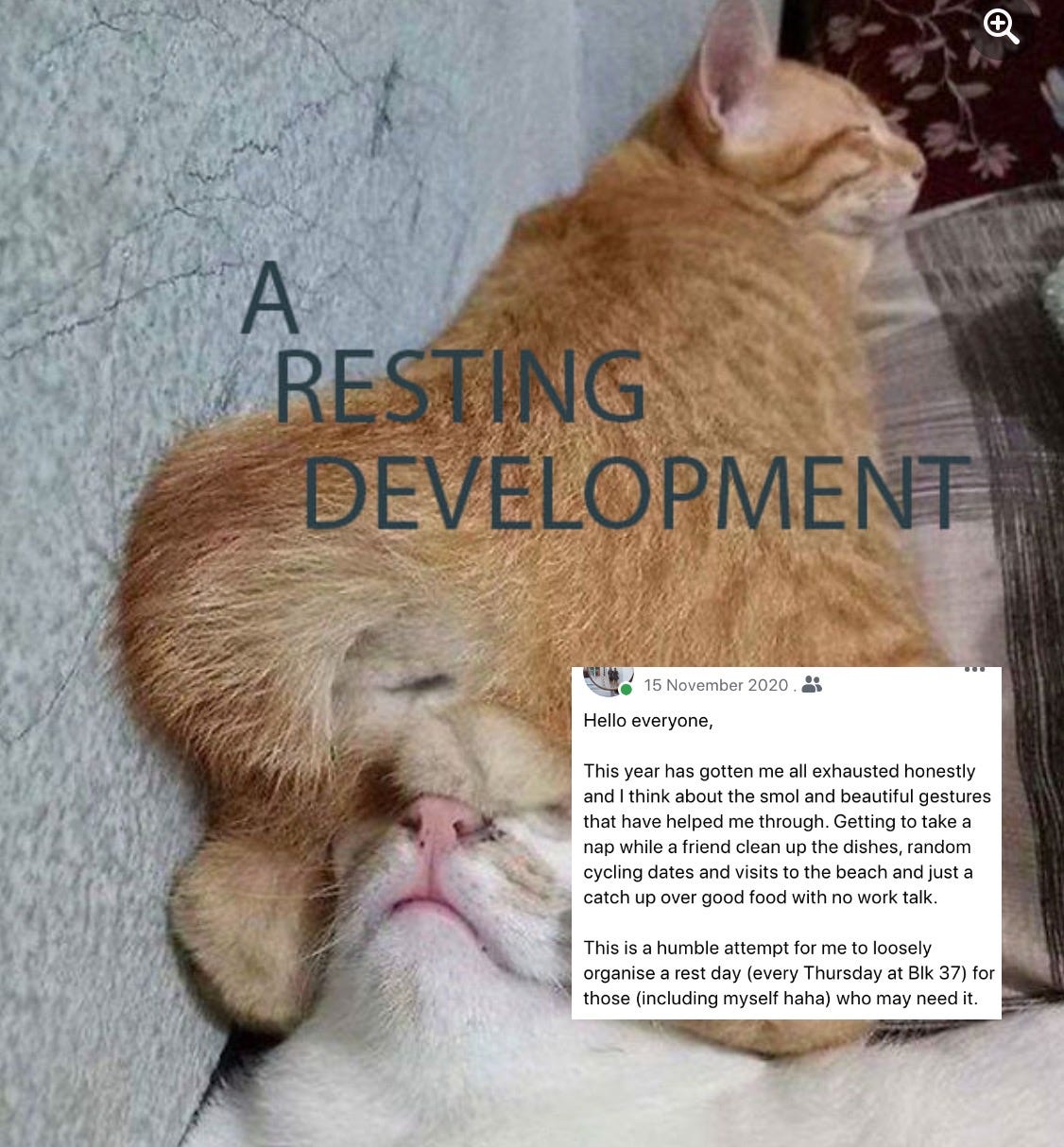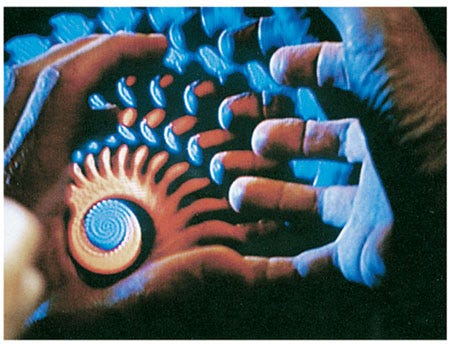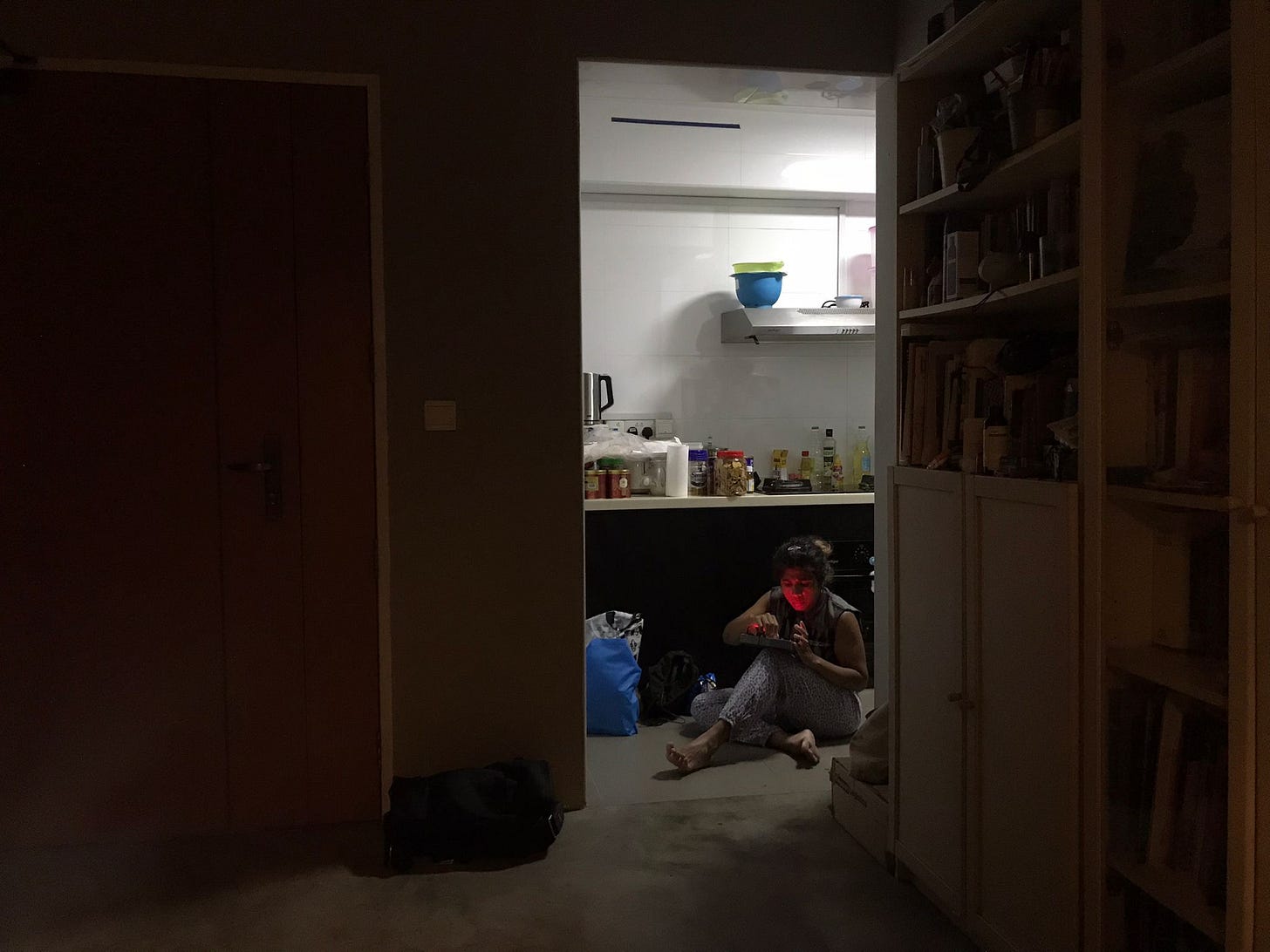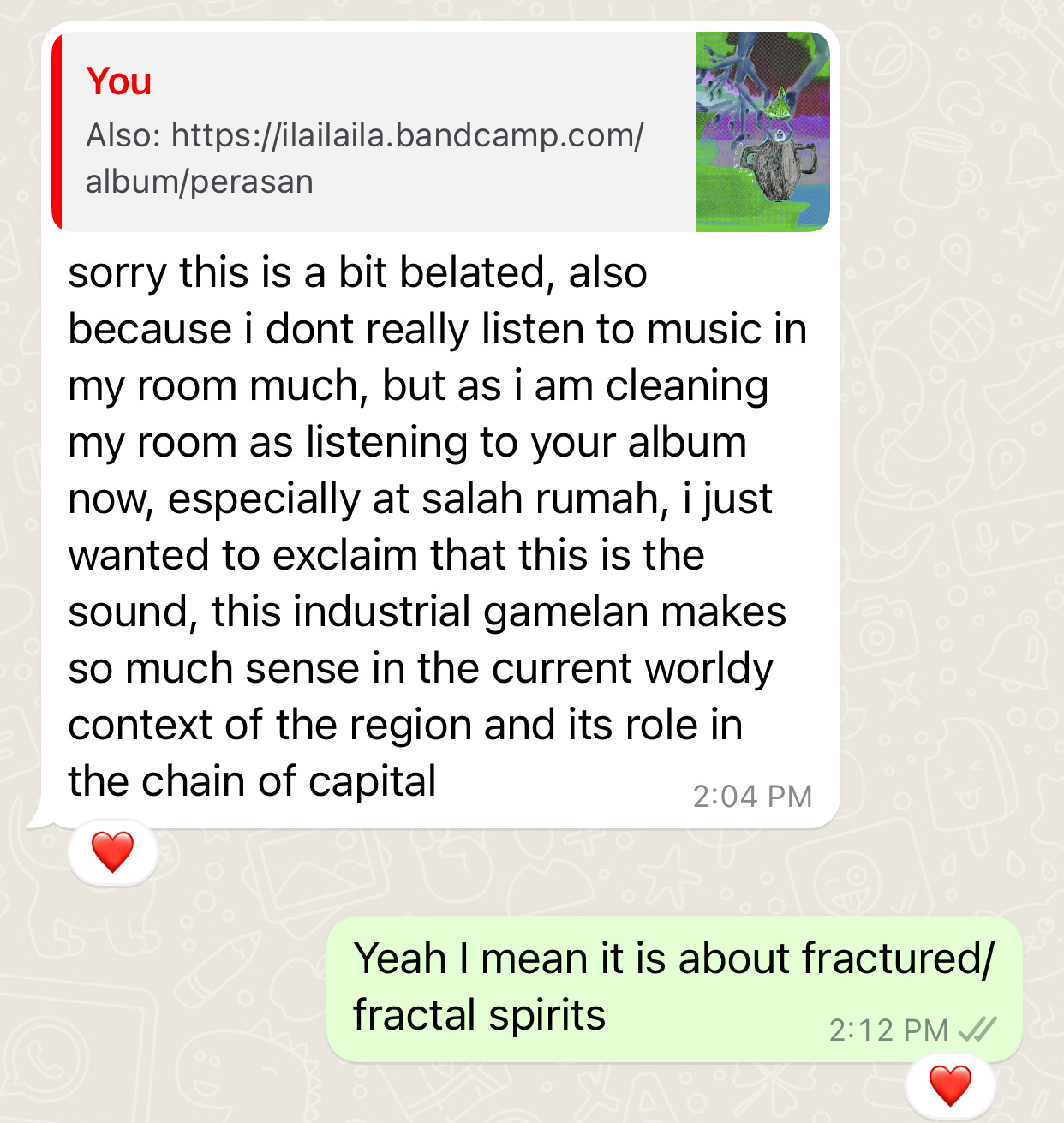(Am I) an eternal return machine of looping spirits (or are we)spirits looping in an eternal return machine (?)
This month I embarked on an eternal return around strange loops, techno spirits in machine city and fractal recursions.
(i) broken spirits in rented bodies
At the peak of the pandemic, that seismic glitch that seems so far away right now as I try to chart a kind of starting point in which all this begin, I spend short days and long nights in a windowless wide space of a studio as part of a residency at NTU Centre for Contemporary Arts. I had the space for six months spread between the last quarter of 2020 and into March of 2021. This white walled room with a heavy door and its four aircon units beating hard against the permeating humidity from backyard of untamed greenery, a secondary forest of sorts with birds, insects and other non-human species that sometimes, especially when the door is left open, seem to come through, the wetness of air or howling, rustling, emerald green shell bodies, bright red rot, burrowing through this seemingly inhospitable concrete slab trying to make it back.
But the space itself was far from inhospitable. The world outside was going through state enforced Circuit Breaker phases in which people are advised to stay home, work and school operate remotely from these home-bases, safety distances are choreographed (rather awkwardly) between bodies in public spaces of one metre marked by yellow tape in boxes and lines. Masks were compulsory unless one is performing heavy sports so running seems to immediately fall under this exception and became a kind of symbolic and pathetic metaphor of outrunning an airborne virus. (Everyone was running or walking really fast). Running from a faceless, no touching city. Running from a hyper-monitored highly surveilled thorny, paranoid, scarce city.
The studio became a hiding place, a glitch in a glitch, softness of unmasked faces of people who have come to gather and breath easy in rarefied and contagious air. I kept invitations open, called it a resting development, a space for anyone to rest, to gather, to play or do nothing. A came over in the early days with their guitar amp, M with her magic microphone with its long wiry tail and broken reverb and these became mainstays of the space, less as features but more as function. Z came over so many times, they were given their own key card access. Nothing was regulated here. Come anytime, at least anytime when I am around. Do whatever. Dance, nap, we even had a makeshift bbq outside that one time, a few birthdays, a lot of nothing time passing in an anti-time space. Rented for awhile space, temporary space. Was this our resistance against loneliness and alienation, against isolation? I don’t know and did not care to define it then and do not care to define it now. All I know for sure was, at that point in time, it was necessary.
During this period, my partner gifted me my first electronic toy, Korg’s Volca Drum, a percussive synthesizer, sequencer that plays a chain of patterns over and over in a loop with allowance to manipulate these patterns via decay, attack, tone, delay into some rhythmic flow. Safe to say, I sucked at it but was utterly obsessed. A little shift on a button and turn on a knob and the pattern modulates but maintains the cycle, returning it again slightly (or vastly) different BUT still in essence, the same. I paired it with my partner’s Microbrute, an analog synthesizer which I had played with for years but could never truly figure out. What an utter delight it was these sounds blaring out from A’s guitar amp loud and alive as I sat cross-legged and achy for hours on end indulging in our flirtatious exchanges, us messy machines.
But this was not the starting point, no not really. The pandemic was an exacerbation of everything that is wrong with the city, you know the economic inequalities, racism, sexism, xenophobia, this city and that city, your city or mine, almost the same city across. Remember panic buys of toilet paper and pasta, or indoor plants probably all dead by now, or quarantined migrant workers and our disregard for their mental health. In Lonely City, Olivia Laing wrote:
“There is a gentrification that is happening to cities, and there is a gentrification that is happening to the emotions too, with a similarly homogenising, whitening, deadening effect. Amidst the glossiness of late capitalism, we are fed the notion that all difficult feeling - depression, anxiety, loneliness, rage - are simply a consequence of unsettled chemistry, a problem to be fixed, rather than a response to structural injustice or, on the other hand, to the native texture of embodiment, of doing time, as David Wojnarowicz memorably put it, in a rented body, with all the attendant grief and frustration that entails.”
How much can our rented bodies take doing time as this grief and frustration is left unacknowledged? What happens to our spirit? What becomes of our spirit when we are not allow to powerless against structural injustices, let alone sit with all this grief, this anger and frustration? When we are told to fix our feelings, to take care of it (not care for it) Can a broken spirit break through the surfaces of our rented bodies and materialise into some other forms, some other structure, some merging? A different rhythm? A kind of spirits sex revitaliser, a fighting back with feelings, with force that is not violent? I don’t know, so many questions and I still don’t know. I conjure all these strands, my fractured spirits, into sounds and made naik angin, with the help of my partner, at the end of my residency. A marker for the time spent in that studio, in a pandemic, in a city that is still sick (with fear?), seeking intimacy with others who are feeling the same ways.
Trust me when I say that this efforted gesture bears no expectations of reciprocity, just presence. It was an incoherent love letter anyways, written in a newly acquired language but from a familiar place, to say I feel this and I feel you and its harsh and cruel and infectious, to say it in other ways, other than words. It’s ok to lose it, to naik angin. It’s really ok. And I came across this review (the only review actually haha) but omg, my love letter resonated and I experienced a recursion of sorts reading it and this especially…As the music charges forward with a primal energy, ila manages to conjure in these tense beats a meditative wind – a response strangely appropriate for an emotionally intense time. Holding onto their ever-dynamic flow, naik angin’s music feels transportive: one that spellbinds and takes away from an anxious present… Yes! Yes! Yes!
(ii) “Ooh, techno city, hope you enjoy your stay; welcome to techno city, you will never want to go away.
Yes it might have all started in that studio in the thick of a pandemic, but some random seed planted itself during those late nights at HQ a year before that. This seed was less deliberate in its tending, I spend those nights mourning, losing myself to dance, until the lights came on Upstairs. There is some unknown pleasure here, I cannot seem to describe but I come out feeling clean, baptised by charged energies almost, unyielding. Powerful.
Before long, the seed was ripe and ready, thriving on a strange combination of curiosity and frustration. Can I emulate these repetitions of 120bpm or higher, the same ds ds ds and imbue them with potency of my own spirit selves tangled unto a larger net of fractured collective spirit that has been beaten down over and over, silenced, put to order in this dreary and cruel place that I’ve known all my life but do not know at all, that I’ve struggled to love but love it all the same because it’s all that I breathe and live and know.
Anyways…enough of that. A short documentary Techno City: What is Detroit Techno? opens with Carl Craig driving down Detroit passing by highly architectured buildings that are dilapidated and abandoned as he recounted its histories, civil rights riots in the 60s a massive recession of automative companies in the 70s…
“Everything started to decay, look at these amazing buildings…The mentality of the machines, considering the assembly line and the automative companies, you know we’ve gotten our inspiration from the decay. We were all pretty interested in synthesizers and drum machine and all that, because of our background in machines with automative factories, we kind of put a soul in that machine…that’s all. techno became what it is today.”
Carl Craig is a central figure to Detroit’s second wave of techno, a distinct sound described as a combination of cool, detached dancefloor beats and textures of European electronic music with the soul and celebration of American funk music and founders of this style often imbue their music with Afro-futurist and science fiction ideals adopting utopian futurist ethos with references to science fiction. Craig continued with:
“…no matter what type of music we do there is always some type of spirit in it, especially with techno, we are dealing with machines, with synthesisers, we have to put some of ourselves into it, and by ourselves I am not meaning just note values, I am meaning spirit, i am meaning heart, that little uumph that needs to go through to make it powerful, to make it definably me, definably Detroit.”In another documentary, Detroit Techno - The Creation of Techno Music, Blake Baxter, a DJ native to Detroit, defines this phenomena as undeniably Detroit, “the whole underground thing, the whole sound…because it’s deprived sound that was trying to get out.” And get out it sure did, in abundance and with clarity.
Two nights ago I put on a track, by Juan Atkins, a third of the Belleville Trio, the founding brothers of Detroit techno. It was my first time listening to it, Techno City, by his duo outfit with Richard Davis, Cybotron. Man what a mind fuck it was to learn that Techno City1 was made in 1984 (I wasn’t even born then). I mean it does feel dated to that era BUT there is also some other quality about it that makes it so infectious, so mmm vital2 It’s not a superficial uplift of shiny gloss of technological promise and capitalistic triumphs, no, not that techno-futurism utopia that most of us grew up with. No, this is the gritty toil of the working class (a mirror of late capitalism woes that came to Detroit earlier than anywhere else and now it’s everywhere. But there are triumphs here too, in the “no fucks given” affirmations to these inequalities. Acceptance IS resistance. Chef’s kiss 10/10. Go listen to Clear and take a walk around your city, you will feel it too for sure.
(iii) I am a strange loop in the little machine of eternal return
(**this part is a little theory heavy so buckle up and settle in or skip it completely if you must because this preface is honestly just me geeking out)
**In I am a Strange Loop, Douglas Hofstadter recounts his experience at a video store as in the 70s. His parents wanted to purchase their first video camera and they were escorted to an area where a video camera was already plugged into the back of one of the many TV screens on a shelf. This was to allow for patrons to be able to see the color accuracy and quality of the “recorded” footage which was wherever the camera was pointed to. Douglas started pointing the camera to his father and immediately a copy of the father’s amused smiled jumped unto the screen. Douglas then pointed the camera to his own face and there he was on the screen, replacing his father. He then hesitated to point the camera at the tv screen itself although felt strongly compelled to “close the loop”.
‘Now comes the really curious fact, which I will forever remember with some degree of shame: I was hesitant to close the loop! Instead of just going ahead and doing it, I balked and timidly asked the salesperson for permission to do so. Now why on earth would I have done such a thing? Well, perhaps it will help if I relate how he replied to my request. What he said was this: “No, no, no! Don’t do that — you’ll break the camera!
And how did I react to his sudden panic? With scorn? With laughter? Did I just go ahead and follow my whim anyway? No. The truth is, I wasn’t quite sure of myself, and his panicky outburst reinforced my vague uneasiness, so I held my desire in check and didn’t do it. Later, though, as we were driving home with our brand-new video camera, I reflected carefully on the matter, and I just couldn’t see where in the world there would have been any danger to the system — either to the camera or to the TV — if I had closed the loop (though a priori either one of them would seem vulnerable to a meltdown). And so when we got home, I gingerly tried pointing the camera at the screen and, mirabile dictu, nothing terrible happened at all.”
Douglas tried to trace his own hesitancy to close the loop, the salesperson’s panic. To create a kind of loop feeding in and out and in from the same source. Here he explains the irrational fear of the feedback:
But danger or no danger, I remember well my hesitation at the store, and so I can easily imagine the salesperson’s panic, irrational though it was. Feedback — making a system turn back or twist back on itself, thus forming some kind of mystically taboo loop — seems to be dangerous, seems to be tempting fate, perhaps even to be intrinsically wrong, whatever that might mean. These are primal, irrational intuitions, and who knows where they come from….We all know that some tribes are fearful of mirrors, many societies are suspicious of cameras, certain religions prohibit making drawings of people, and so forth. Making representations of one’s own self is seen as suspicious, weird, and perhaps ultimately fatal. This suspicion of loops just runs in our human grain, it would seem.
I cannot deny this mystically taboo loop feeling when I experience a pattern of recursion. It’s pretty chilling, this feeling, but also kinda powerful. A strange return of sorts I wrote about last month. But also that fear of the uncanny where a copy that is not quite a copy anymore returns and confronts the source, something I’ve written about too. Anyway, probably stemming from his desire to trace this fear, Douglas embarked on what he called video voyages in which he experimented in creating different kinds of video feedback from a super simple set-up of camera unto a TV screen, which was replicated again three decades later, with the help of his editor and better technology, in which they’d spent many delightful hours sailing the same old seas but in a somewhat newer craft.
Documenting the various and variegated experiments and results in both timelines, I found two aspects of his discoveries deeply astounding.
Enigmatic, Emergent Reverberation
Douglas accidentally covered the camera with his hand which rendered the screen blank before instinctively pulling it away. Instead of the screen reverting back to the mirrored screen which had been stationary, the captured image was throbbing. Pulsating like a heartbeat. At first Douglas was like wtf, there is nothing in this room that is moving so what’s causing this reverberation on screen?
“…an image was of itself (albeit at a slight delay), it is in fact quite to the point. A faithful image of something changing will itself necessarily keep changing! In this case, motion begat motion endlessly because I was dealing with a cyclic setup — a loop. And the original motion that had set things going — the prime mover — had been my hand’s motion, of which this video reverberation now constituted a stable, self-sustaining visible memory trace!”
Douglas admits that, after all these years, the origins of such pulsation remains a mystery and thus is considered to be an emergent phenomenon (also known as ephiphenomenon3) Basically stuff emerges quite naturally and automatically from rigid rules that are operating at a lower and more basic level but how (or why) it happens remain unclear but somehow “makes sense”.
The Phenomenon of Locking-In
I have been struck by the fact that it is the circularity — the loopiness — of the system that brings these patterns into existence and makes them persist. To put it another way, feedback gives rise to a new kind of abstract phenomenon that can be called “locking-in”. From just the barest hint (the very first image sent to the TV screen in the first tiny fraction of a second) comes, almost instantly (after perhaps twenty or thirty iterations), the full realization of all the implications of this hint — this epiphenomenon, is then “locked in”, thanks to the loop. It will not go away because it is forever refreshing itself, feeding on itself, giving rebirth to itself. Otherwise put, the emergent output pattern is a self-stabilizing structure whose origins, despite the simplicity of the feedback loop itself, are nearly impenetrable because the loop is cycled through so many times.
**
So ila, where is this going? Well let me bring you around (get it?) to the point where we left off. What is this unknown pleasure I feel? Probably the same as Douglas in his many hours of journeying through endless permutations of his video feedback experiment? I feel it when I am a dance floor lost in a repetition of beats and pulses, among other flesh bodies. A positive feedback that amplifies and amplifies until what, or where, I don’t care really because it feels so fucking good.
So a year later, there I was sitting in my room. My leg pressed hard against the same guitar amp I was using at the studio, sounds vibrating from a different machine, a Volca sample sequencer. Also a gift from my partner who felt I was ready to elevate my tiny set-up. This little cutie comes with its own library and an option to upload samples of basically ANYTHING. The possibilities are limitless tbh but these samples are small in duration, preferably less than five seconds. I went a little crazy, and fed the machine my childhood bits and pieces, lines I knew by heart from old P Ramlee films, that shouting larger larger larger part from Born Slippy, Leeloo going big badaboom Deborah Harry isolated vocals and many many other things. A mix bag of pure nostalgic ghosts in a little loopy machine, merging and emerging for hours and hours.
Maybe the fascination with the loop, to me not at all taboo but still mystical, is being able to experience that recursion over and over again. To witness it and have a hand in its making and its death, again and again. I see it forever refreshing itself, feeding on itself, giving birth to itself, a reverberating dancing spirit, with parts of me still recognisable but other parts emerging wild and unabated, mysterious, uncontrollable. There is something here, a deeper and unknowable force at play. A strange loop that is both positive and negative in its manifestations and very much alive.
(IV) (tbc) On Fractals, Fractures and making of perasan
If naik angin manifested from all that was wrong with this city, perasan came from a desire to allow ourselves to slip and spiral, to notice these feelings (perasan perasaan) and just sit with them, dance with them, make some kind of mischief with them, hold them close, no no, much closer and return to ourselves again and again. perasan is an accumulation of energies, heart and spirit, mine and yours and this city right here and in all the other fractured cities.
But we have been allowing ourselves that and as I am drowning in the eternal return of a world of hopelessness and isolation, I am carried back to the shoreline each time by drawing my attention to or being pulled towards this other eternal world which Nietzsche described as:
And do you also know what “the world” is to me? Should I show it to you in my mirror? This world: a colossus [Ungeheuer] of energy, without beginning, without end, a firm, unshakable magnitude of energy that does not get bigger, does not get smaller, that does not expend itself but only transforms itself, as a whole unchangeable in size, an economy without expenditures and losses, but likewise without growth, without income, encased by “nothingness” as by its border, nothing blurring, wasted, nothing infinitely extended, but laid into a definite space as a definite force, and not a space that would be “empty” anywhere, rather as force everywhere, as play of forces and waves of forces . . . this my Dionysian world of eternal self-creating, of eternal self-destroying, this mystery-world of the doubly voluptuous, this my beyond good and evil, without goal, if a goal does not lie in the happiness of the circle, without will, if a ring does not have good will for itself—do you want a name for this world? A solution for all its riddles? a light for you too, you hiddenmost, strongest, most intrepid, most midnightly?—This world is the will to power—and nothing else! And you yourselves are also this will to power—and nothing else!
And here is a light for you too, “where only difference return, and not the same”
I wanted to go on a little bit more on fractals and loops. But in another time on another recursive branching out (and in) perhaps.
Till next time my loves, and may you fall into some fractional loop of pleasure and bliss that goes on and on and on.
"Techno City was divided into different sectors, the privileged sector in the clouds and the underground workers' city."
"The idea was that a person could be born and raised in Techno City, the workers' city, but what he wanted to do was work his way to the cybodrome where artists and intellectuals reside. There would be no Moloch, but all sorts of diversions, games, electronic instruments. Techno City was the equivalent of the ghetto in Detroit, which is overlooked by the Renaissance Tower."
If I had a better working knowledge of Greek, I’d have known that the prefix epi– means “upon, at, close upon (in space or time), on the occasion of, in addition, also.”
In any case, it turns out that an epiphenomenon is a secondary effect or byproduct that arises from a process. The word has two distinct senses: one that suggests known causation and one that suggests the absence of causation, or, at least, a reservation of judgment about it.







